
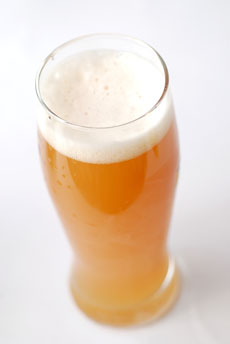 Gruut, a Belgian wheat beer, can appear cloudy. Photo by Kriss Szkurlatowski | SXC. Gruut, a Belgian wheat beer, can appear cloudy. Photo by Kriss Szkurlatowski | SXC.
February 2005
Last Updated July 2025
|
|
Beer Type
Page 4: Beer Types ~ F To K
This is Page 4 of an eight-page glossary of beer terms and beer types. Click on the black links below to visit other pages. Also see our many other food glossaries, chock-full of information about your favorite foods.
This glossary is protected by copyright and cannot be reproduced in whole or part.
You are welcome to link to it.
FRAMBOISE or FRAMBOZEN
Raspberry beer, usually made from lambic. See also fruit beer, below, and kriek.
FRESH BEER
Fresh beer refers to beer that is consumed shortly after brewing, ideally within a few weeks of release, when its flavors are at their peak. Beer is not meant for aging (except certain styles—see Aged Beer). It can go stale, developing off-flavors like cardboard or sourness due to oxidation. Freshness is particularly important for certain beer styles: light lagers/Pilseners, wheat beers, and hop-forward beers like IPAs, as the aromas and flavors from fresh hops degrade quickly.
FRUIT BEER
Belgians pioneered fruit beer, ignoring the German Purity Law of 1516 that stipulated that beer could only be brewed with barley, hops, and water (no one yet knew about the wild yeast). Lambic styles were produced in flavors like cherry (kriek), peach, and raspberry. Today, they are made in dozens of flavors. Traditionally, the fruit was fermented with the grain. Modern breweries may use flavored extracts as a shortcut to the finished product (and, not surprisingly, they don’t taste nearly as good). Check the label or online to find those brewed with real fruit. Here’s more about fruit beer.
GOSE BEER
Gose (pronounced GOES-ah) is a German sour beer that is slightly tart. The style is more than 1,000 years old, and is traditionally brewed with coriander and salt. It is now experiencing a resurgence among craft brewers. It is light, refreshing, and slightly sour. Enjoy it as an aperitif, or pair with fresh cheeses, asparagus, and light desserts. It is often confused with gauze (see below), another slightly sour, wheat-based beer, but they are unrelated. Here’s more about them.
November 17 is International Happy Gose Day. September 8th is National Sour Beer Day.
|
|

It “gose” with anything (photo © Homebrewers Association). |
GERMAN BEER
German beer refers to any beer brewed in Germany, renowned for its diverse styles and adherence to the Reinheitsgebot (German Beer Purity Law), which dictates that beer can only be made with four ingredients: water, malt, hops, and yeast.
German beers include lagers like Pilsner, Export, and Helles, as well as wheat beers like Dunkelweizen and Weissbier, and other styles such as Altbier, Kölsch, and Schwarzbier .
April 23rd is German Beer Day.
|
|

With all due respect, this Dunkelweizen is brewed in Arizona (photo © Wanderlust Brewery). |
GRAVITY
As it applies to fermenting alcoholic beverages, gravity refers to the relative density of the alcoholic beverage compared to water. The measure is used by brewers and winemakers.
|
GROWLER
A growler is a half-gallon glass jug used to transport draft beer home from the tavern or brewery (32-ounce growlers are now available). While it was the only way to get beer home, short of brewing it yourself, the format has returned recently due to the desire of craft beer enthusiasts to take home fresh beer on tap from microbreweries. In the old days, growlers had hinged porcelain gasket caps; today, a screw-on cap is as likely (and less expensive). A properly sealed growler will hold carbonation indefinitely, just like any other sealed beer bottle. And it’s more “green” to buy beer in a growler than to go through many smaller bottles or cans. Most places that sell growlers take them back for refilling.
|
|
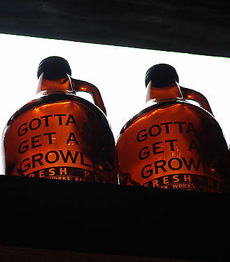
A 64-ounce growler. Photo courtesy SimpleSteps.org. |
Why “growler?” In the late 19th century, before the appearance of the glass jug, fresh beer was carried home from the local pub in a galvanized, lidded tin pail. Some claim that the sound made by the carbon dioxide escaping through the lid as the beer sloshed back and forth sounded like a growl.
GUEUZE
Pronounced GOOZ, gueuze dry style of lambic, made without fruit. It is a spontaneously fermented lambic, which is a blend of several different years of barrel-aged beer. Called the “champagne of beer,” gueuze is kept in old oak barrels that have generational colonies of bacteria. These give gueuze its natural tart flavor; the beer is naturally effervescent. Like champagne, gueuze is bottled immediately after blending and undergoes a secondary fermentation using the active yeasts and sugars still remaining in the beer. Unlike most beers, a traditional, dry gueuze benefits from at least two years of cellaring and can be cellared for twenty to thirty years, becoming more mellow and earthy over time.
GRUIT or GRUUT
Gruit is an herbal mixture used to flavor and preserve beer. It was used in medieval Europe before the widespread adoption of hops as a flavoring and preservative. It remains key in Belgian witbier, wheat beer. Gruut is a word from Middle Dutch, but it has also been adopted into English and German as gruit
HEFEWEIZEN or HEFE-WEIZEN
A wheat beer (Hefeweizen is German for “yeast wheat”—Hefe is the word for yeast) in which the beer is not filtered before bottling. Thus, the yeast continues to act (known as bottle conditioning), and there may be sediment in the bottle. Also called Hefeweisse, Hefeweissbier, and Weissbier. Some Weizenstarkbiers (high-alcohol wheat beers) are left unfiltered, and therefore are Hefeweizens. The body is crisp and effervescent.
HELL
Rather than a bottle of fire and brimstone, hell is simply the German word for “pale,” and indicates an everyday beer that is golden in color.
HOLIDAYS
There are more than 38 beer holidays celebrated each year. Check them out and start planning to celebrate.
HOMEBREW
Homebrew refers to beer or other alcoholic beverages brewed at home for personal, non-commercial use. It’s a hobby that allows individuals to create their own unique beverages. Supplies for homebrewing are readily available at specialty stores and online.
The first Saturday of November is Learn to Homebrew Day. October 14th is Homebrewing Legalization Day, signed into law by President Jimmy Carter in 1978.
|
HOP
Hops (Humulus lupulus) are climbing plants, much like a grape vine. Without hops, there would be no beer as we know it. Hops are used to impart beer’s bitter, tangy flavor and help to stabilize and preserve the beer. Hops were cultivated in Bavaria and elsewhere from the 8th or 9th century, but are not mentioned as a bittering agent for beer until perhaps the 11th century. Prior to then, brewers used a variety of bitter herbs and other plants to achieve the desired results. Today, craft brewers are so sensitive to the flavors yielded by hops from different terroirs that they purchase hops grown in particular areas to impart specific flavors to their beers. Fresh hops must be used within hours of harvesting to get the most from their oils.
|
|
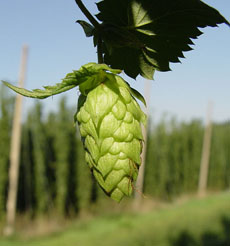
The cone-like blossoms on hops (called seed cones or strobiles) contain the tannins, which help preserve and clarify beer and are the essential ingredients that impart aroma, dryness, and bitter flavors. Photo by Lucky Starr | Wikimedia. |
I.B.U. or IBU
International Bittering Unit, a comparative measure of the amount of bitterness in a beer. A low IBU, 5–20, comprises mild beers like American lagers and wheat beers. A medium IBU, 20–40, is found in pale ales, amber ales, and brown ales. A
high IBU, 40–120+, is found in IPAs, double IPAs, imperial stouts, and extreme beers.
Most humans can’t perceive bitterness much beyond ~100 IBU. Above that, it becomes theoretical. So while beers can chemically test above 1,000 IBU, they won’t taste that bitter. But for marketing and PR purposes, some brewers go wild.
Hoppiness Is an Imperial Measurement, brewed by Flying Monkeys Craft Brewery (Canada), claims an IBU of 2,500! Other contenders are Mikkeller’s 1000 IBU and Dogfish Head’s Hoo Lawd, 658 IBU.
|
ICE BEER
See Eisbier.
IMPERIAL BROWN ALE
A bigger, bolder version of a brown ale, with a higher ABV—7% or more.
IMPERIAL STOUT
An opaque black stout that was originally brewed by Thrale’s Brewery in London, England, for export to the court of the Tsar of Russia. It is very rich, with powerful malt flavors, hints of dark fruits, and often, chocolate notes. The high alcohol content (generally 9% to 10%) was originally intended to preserve it during the long journey, as well as to provide fortitude in the cold Russian climate. Also known as Imperial Russian Stout or Russian Imperial Stout.
|
|
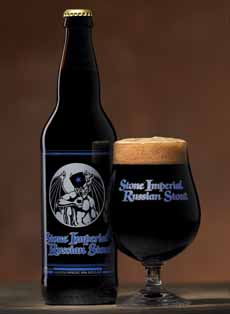
Brown-black with a creamy coffee head, Imperial Stout is complex and high in alcohol. Photo courtesy Stone Brewing Co. |
|
INDIA PALE ALE or IPA
The pale ales of the early 18th century were lightly hopped, but by the mid-18th century, they evolved; most were manufactured with coke-fired malt, which produced an even paler ale via less smoking and roasting of barley in the malting process. One particular variety of pale ale was called October beer. It was well-hopped and then cellared for two years. In the 19th century, the British living in the Indian Empire drank ale from England, largely because the Indian water supply had microbes that caused digestive problems to humans not raised on it. But not all beer could hold up on the long journey in a hot ship’s hold. IPA had the level of alcohol (7%-8%) and hops (which act as a preservative) to withstand the voyage of up to six months.
|
|
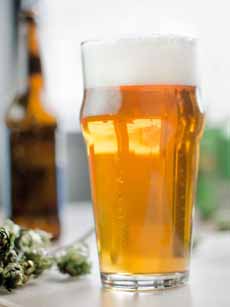
India Pale Ale along with some hops. Photo courtesy Homebrewers Association.
|
Today, transportation problems have been solved, and there’s plenty of bottled water for travelers in foreign lands. The IPA style has evolved (or devolved, in the case of British IPAs, to 5.5% ABV), but is still highly hopped. American IPAs tend more toward old style. Serve an IPA with robust food: red meat and strong cheese.
See also Juicy & Hazy & Juicy IPA, below.
Here’s more about IPA, including the different American IPA styles: East Coast, West Coast, and New England.
National IPA Day is celebrated on the first Thursday in August.
IRISH ALE or IRISH RED ALE
See red ale.
JUICY & HAZY IPA
In 2018, the Brewers Association officially established three new types of IPA. Previously referred to as New England-style IPA, the treatment of hops creates tropical aromas and flavors. The three new styles are Juicy & Hazy Pale Ale, Juicy & Hazy IPA, and Juicy & Hazy Double IPA. Here’s more about them. National IPA Day is celebrated on the first Thursday in August.
KELLERBIER
An unfiltered lager with a high hop content and low carbonation.
|
|
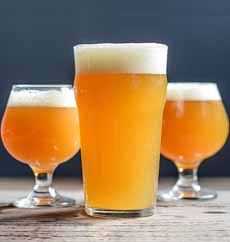
New IPA styles: Juicy & Hazy (photo courtesy The Brewers Association). |
KLOSTER BIER or CLOISTER BEER
A beer that is, or formerly was, produced in a monastery or convent. See also Abbey beer and Trappist bier.
KÖLSCH BIER
Beer in the style of the city of Koln (Cologne), Germany; it can legally be produced only in the Koln-Bonn metropolitan area. Kölsch is a top-fermented beer producing a light, refreshing (but dry) pale golden ale with soft, layered flavors that have a delicate fruitiness and a prominent hoppiness. It is usually served in tall, slender glasses. Kölsch can be paired with cervelat, a mildly seasoned, mildly smoked, semi-dry sausage.
|
KRIEK
Cherry beer, usually based on lambic, with 5% to 6% alcohol by volume.
KRISTALLWEIZEN
A German filtered wheat beer. Kristall is the German word for crystal, which indicates that the beer will be clear, not cloudy (as opposed to a Hefeweizen, which might have sediment). It is often served with a slice of lemon on the rim of the glass, or in the glass, similar to the lime served with Mexico’s Corona beer. Also known as Kristall Weissbier.
|
|
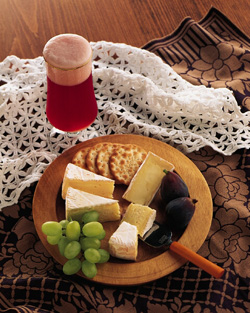
Cherry kriek with Brie, figs, and grapes. Photo courtesy of Wisconsin Milk Marketing Board.
|
Continue To Page 5: Terms Beginning With L To M
Go To The Article Index Above
Some terms in this glossary are © 2005 National Beer Wholesalers Association. All rights reserved. Other content is © Lifestyle Direct Inc. All rights reserved.

|